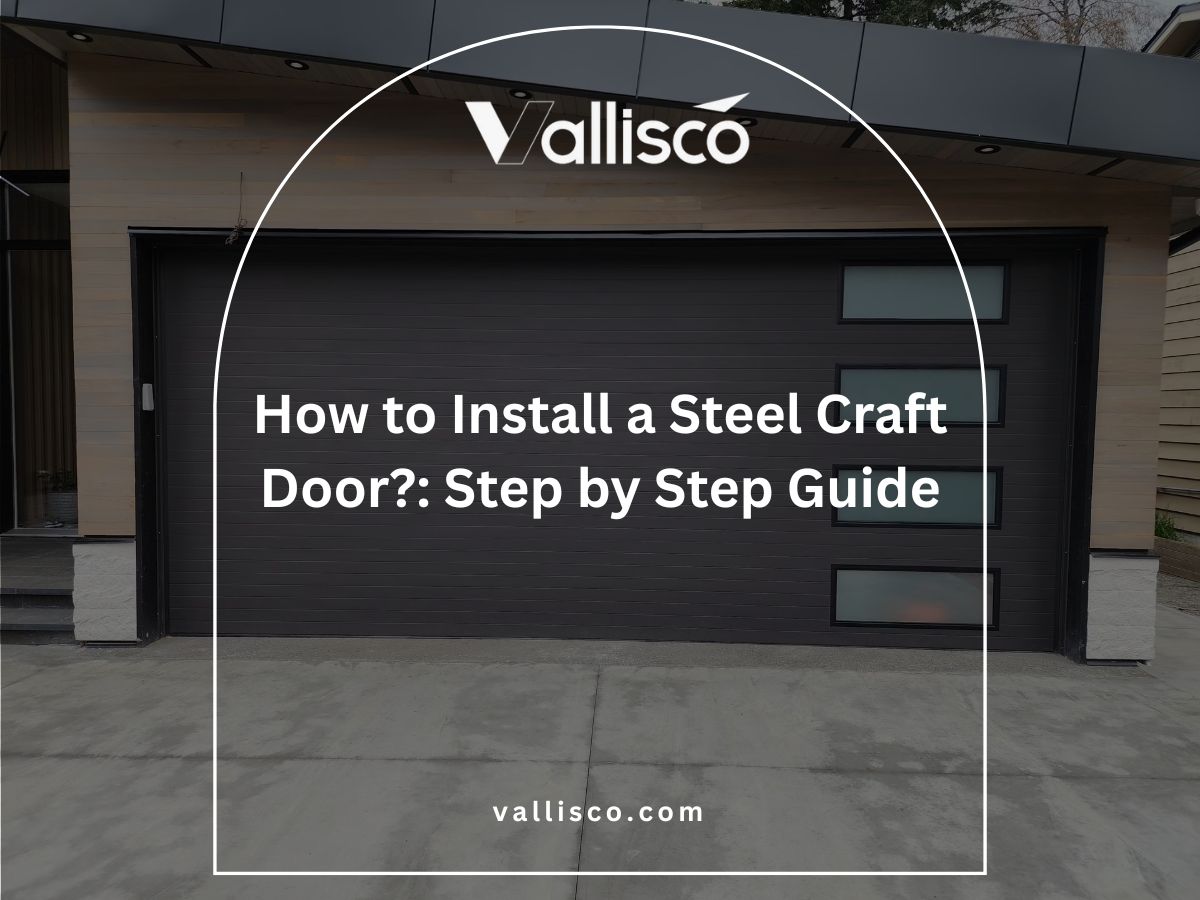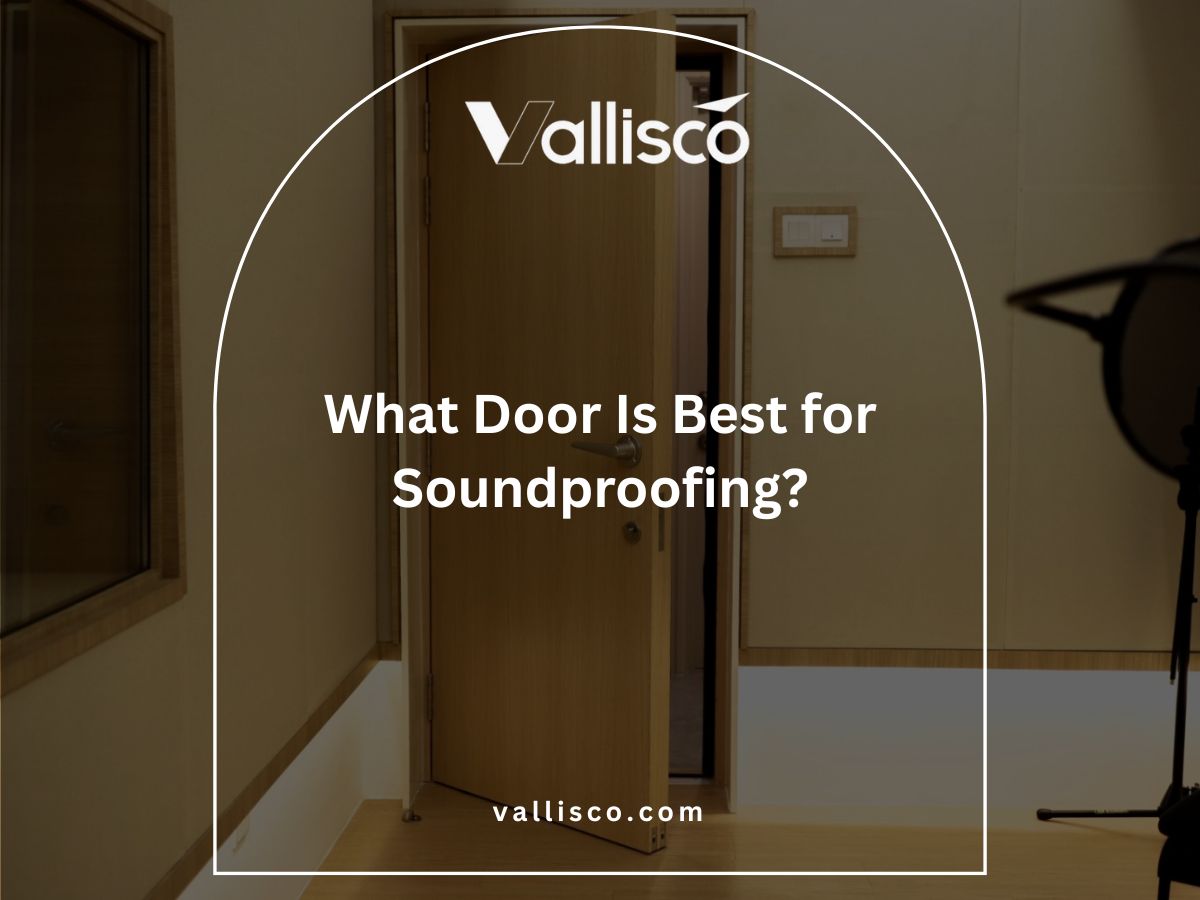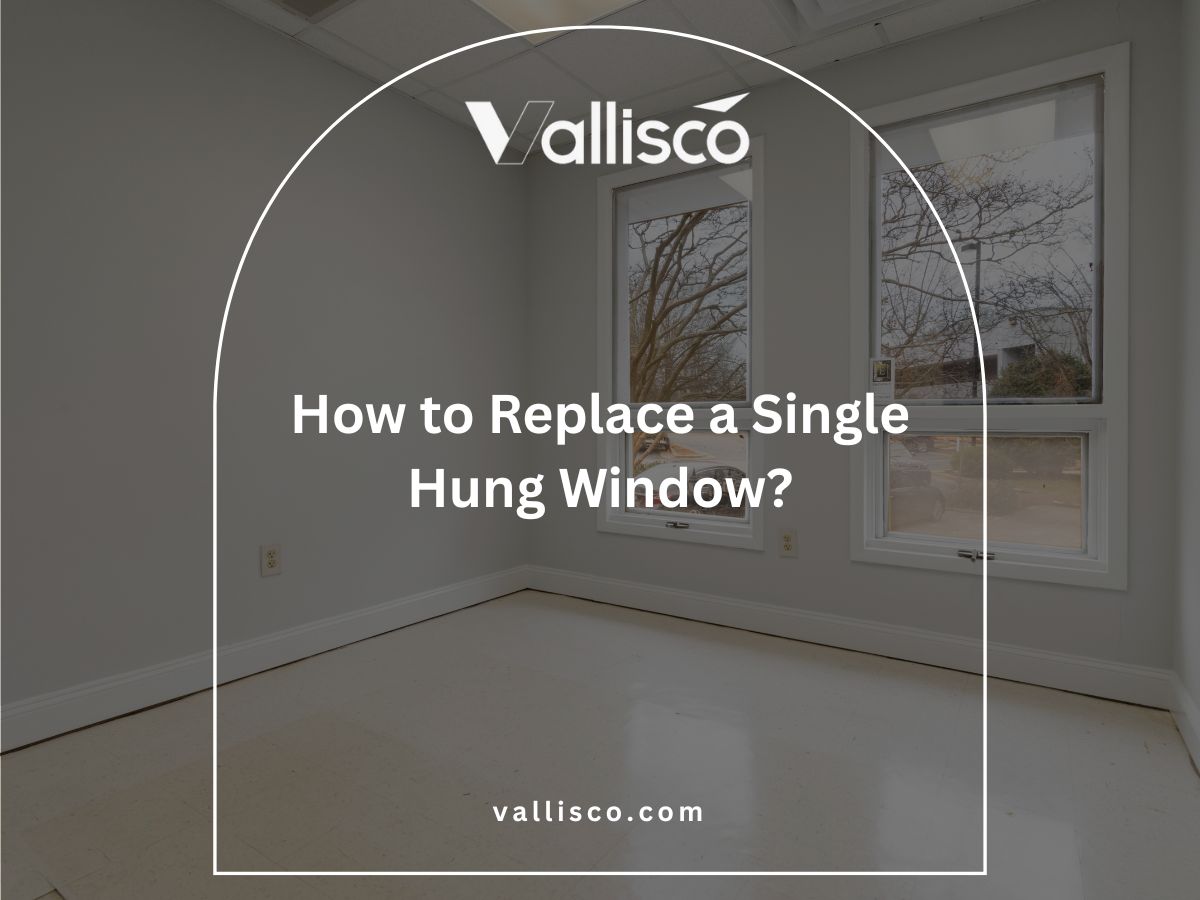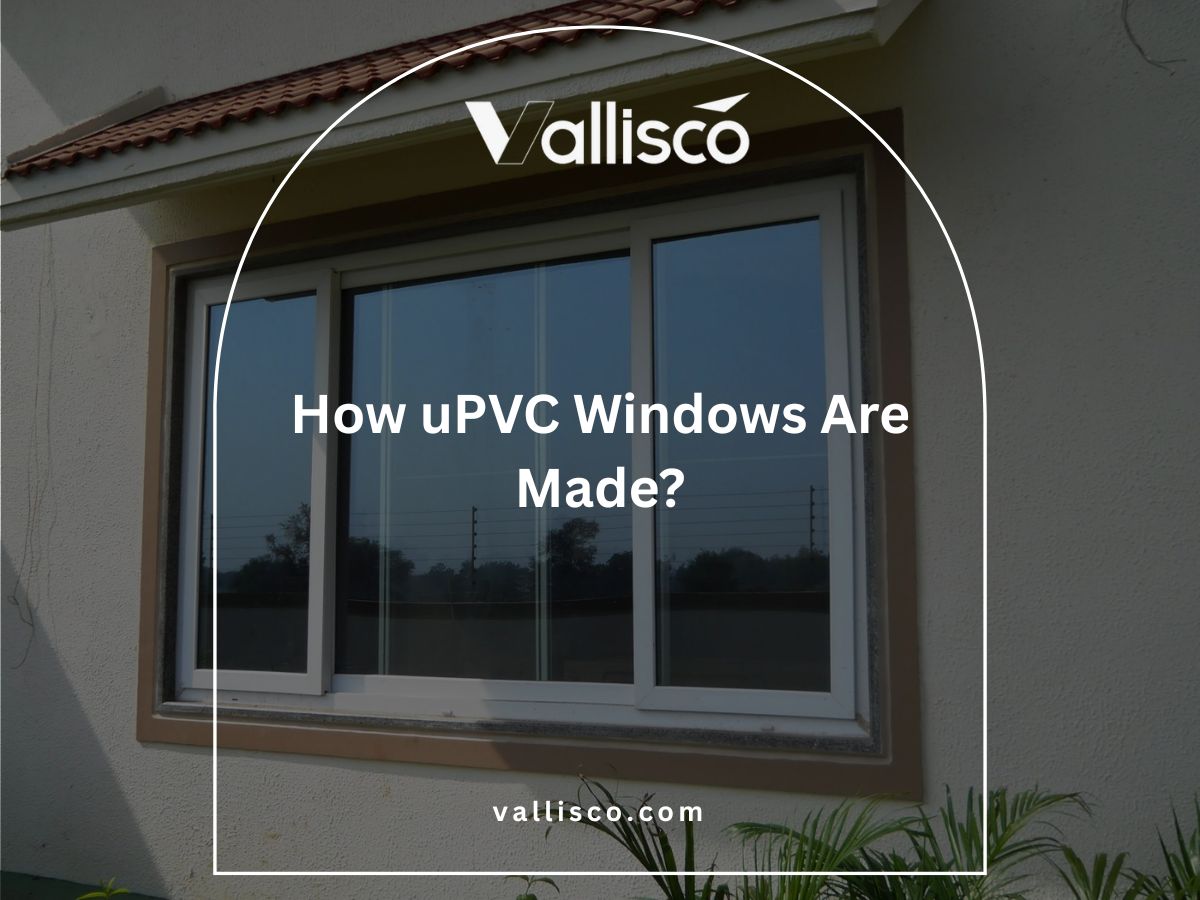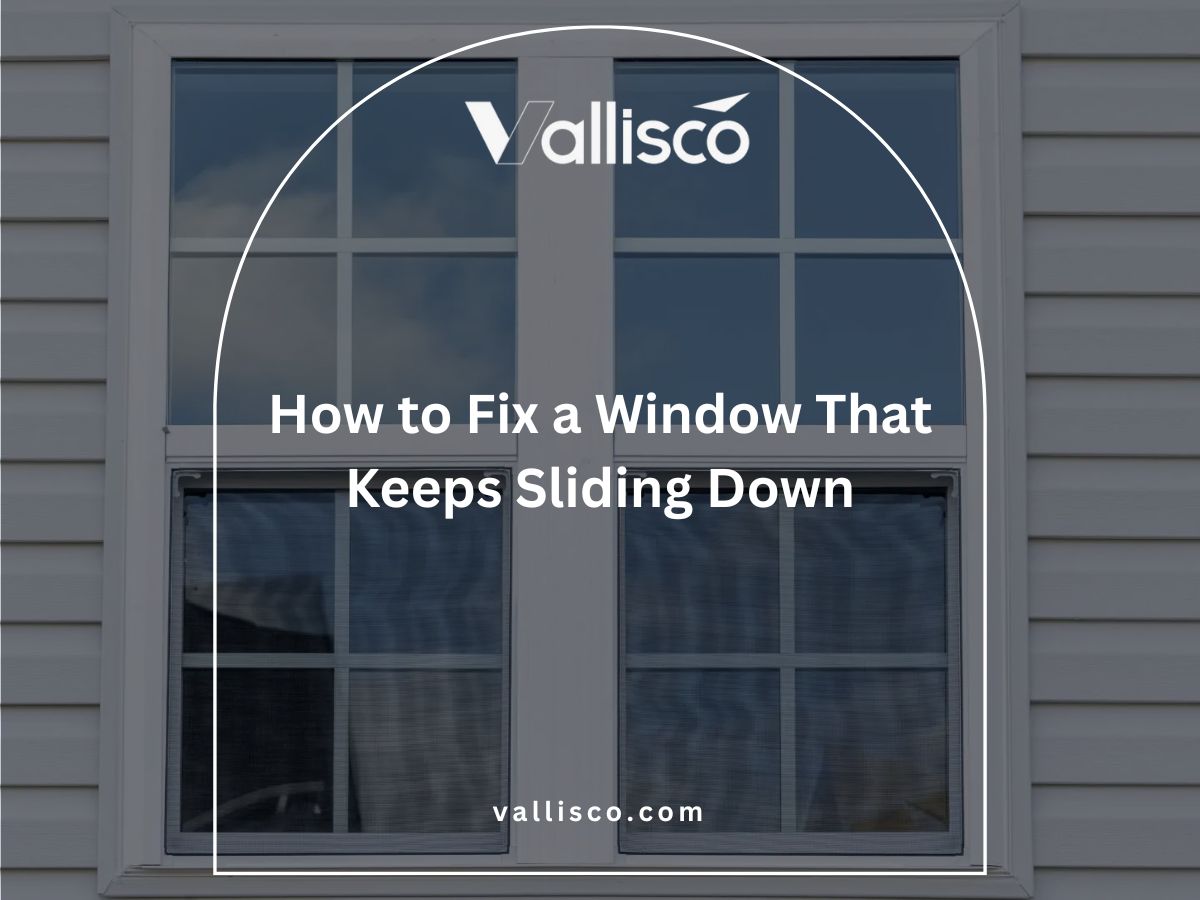One of our B&B clients in Europe shared this: “We picked the wrong door type and had to rework the whole wall.” That mistake cost them a week and extra labor.
You don’t want to be in that spot. Choosing the right type the first time saves time and money.
I’ve worked with many property owners and engineers on door planning. My input is based on real jobs and client feedback.
In this guide, I’ll compare pocket doors and barn doors clearly and directly. You’ll find the pros, cons, and how they perform in different projects.
If you’re deciding between these two, this review will help you get it right.
Now, let’s dive in!
Quick Comparison Chart
If you’re comparing options for your build or renovation project, this chart gives you the highlights. It’s based on how these doors perform in real jobs, not just what looks good on paper.
| Feature | Pocket Door | Barn Door | Notes |
| Space Efficiency | Saves floor space and hides inside the wall | Saves floor space but needs clear wall to slide | Pocket doors are better for very tight rooms or corridors |
| Installation Complexity | Higher, needs wall cavity and skilled labor | Lower, mounts on wall, faster to install | Barn doors are better for quick builds or retrofit projects |
| Privacy and Soundproofing | Moderate privacy and better sealing | Low privacy and sound passes through easily | Use pocket doors for bedrooms or private baths |
| Aesthetic Appeal | Clean, minimal, blends into wall | Bold, decorative, adds visual interest | Barn doors add more style if visibility is part of the design goal |
| Durability & Maintenance | Durable but harder to access for repairs | Exposed parts are easier to inspect and fix | Pocket door repairs may require wall access |
| Moisture & Climate | Needs good wall sealing to avoid moisture issues | Handles airflow better, but finish still matters | Barn doors work better in humid zones if well-finished |
| Cost Considerations | Higher due to hidden parts and wall work | Lower labor cost, flexible pricing options | Barn doors are often more budget-friendly and scalable |
| Best For | Small rooms, clean designs, space-saving projects | Open layouts, quick installs, decorative use | Match the choice with your layout, build stage, and design goals |
The full article below goes into more detail with real use cases, pros and cons, and tips. If you’re still deciding what fits your project, down to get the full picture.
1. What is a Pocket Door?
A pocket door is a sliding door that disappears into a hollow space inside the wall. When open, it hides completely. You don’t see it hanging on the outside like a barn door.
This type of door is useful in rooms where space is tight. I’ve seen it work well in bathrooms, laundry areas, or between rooms that need to stay open most of the time.
If you’re working on a villa, hotel, or B&B where every square meter counts, a pocket door can give you more usable space. You don’t have to leave room for a door to swing open. That’s a big deal in compact layouts.
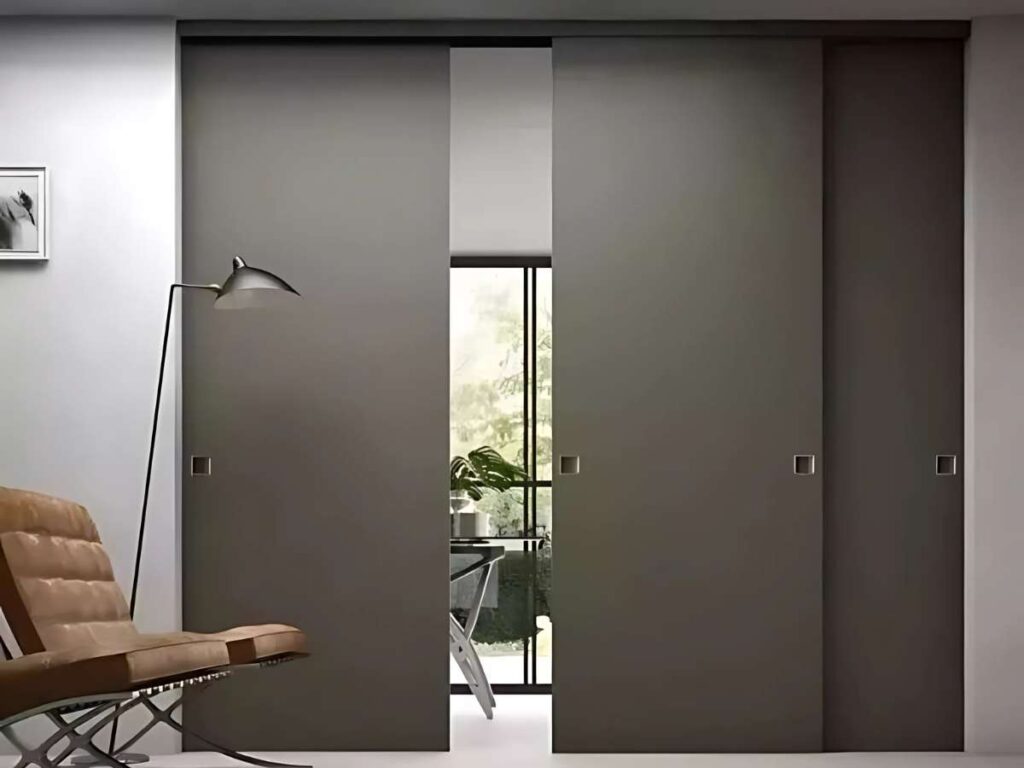
2. What is a Barn Door?
A barn door slides along the outside of the wall. It stays visible even when it’s open. It hangs from a rail mounted above the door frame and slides left or right to open or close.
Unlike a pocket door, it doesn’t need space inside the wall. But it does need free wall space next to the opening.
I’ve seen barn doors used in villas, hotel rooms, and office areas. They’re often chosen for their look, but they’re also easier to install. If you don’t want to open up a wall or deal with hidden hardware, this could be the simpler option for your project.

3. Space Efficiency
I often get asked which door saves more space. The answer depends on how much wall clearance you have and what type of layout you’re working with. Let’s look at how each option works in tight or busy areas:
Pocket Door
- No Swing Area Needed: A pocket door slides into the wall, so you don’t need to leave space for the door to swing open. This makes it ideal for small rooms or narrow hallways.
- Wall Space Stays Clear: Because the door hides inside the wall, you can use both sides of the wall for furniture or decor. I’ve seen this help a lot in guest rooms and tight office corners.
- Better Flow Between Rooms: Pocket doors let you open up 2 rooms without a door getting in the way. This helps in open-plan layouts where flow matters.
- Great for Multi-Use Rooms: If a room has more than one function, like a work area that doubles as a guest room, a pocket door keeps it flexible without taking up space.
- More Floor Space to Work With: You get back the space that a swinging door usually blocks. That can make a big difference in small properties.
Barn Door
- No Floor Swing Needed: Like a pocket door, a barn door doesn’t swing open, so it saves floor space. This is helpful where you have furniture or tight walkways.
- Needs Wall Space to Slide: One side of the wall must stay clear so the door can slide open fully. If there’s a light switch, shelf, or painting in the way, you’ll need to move it.
- Good for Wide Openings: Barn doors can be built large to cover wider spaces. This works well in lobbies or shared rooms that need a flexible divider.
- Adds Visual Size to a Room: A barn door adds a strong visual element and can make a room feel larger when open. But it’s always visible, which may or may not suit your style.
- Not Ideal for Tight Corners: If you don’t have enough wall space next to the door, a barn door won’t fully open. I’ve run into this in smaller bathrooms and kitchens.
Final Thoughts
Both door types can help you save space, but in different ways. If wall space isn’t a problem, barn doors are simple and practical. But if you want a clean, hidden solution that frees up every inch, pocket doors often make more sense. Think about your layout and how the space will be used. That usually points you to the better option.

4. Installation Complexity
The way each door is installed affects cost, labor time, and even wall structure. I’ve seen many projects get delayed just because the team didn’t plan for the type of door early enough. Here’s what you need to know:
Pocket Door
- Wall Modification Is Required: A pocket door needs to slide into a hidden compartment inside the wall. That means tearing down part of the wall or planning the frame during early construction. It’s easier in new builds than in renovations.
- Electrical and Plumbing May Be Affected: If there are wires or pipes in the wall where the door will go, they need to be moved. This can add time and cost if not addressed early.
- More Precise Framing: The frame for a pocket door has to be level and sturdy. Any slight misalignment can cause the door to stick or not slide smoothly.
- Harder to Retrofit: Adding a pocket door to an existing room takes more time and coordination. I usually recommend it only if you’re already opening up the walls for other work.
- Sliding System Needs Careful Setup: The track is hidden inside the wall, so it must be installed correctly the first time. If something goes wrong later, repairs can be tricky.
Barn Door
- Mounts on Surface of Wall: A barn door is mounted outside the wall, so there’s no need to cut into it. This makes it easier and quicker to install, especially during remodels.
- Wall Must Hold the Weight: You’ll need a strong header or beam above the doorway. The sliding hardware and door weight must be supported properly to avoid sagging.
- Simple to Access for Repairs: If the rail or door needs fixing later, it’s all exposed. This makes maintenance easier compared to pocket doors.
- Less Impact on Surrounding Systems: Since the door doesn’t go inside the wall, electrical and plumbing systems are usually left untouched. That reduces the chance of delays.
- Installation Is Faster: Most barn doors can be installed in one day. If your project is on a tight schedule, this option saves time and avoids wall work.
Final Thoughts
If your project timeline is short or you’re working on an existing space, barn doors are the easier route. But if you’re building new or doing major changes, pocket doors are still an option, you just need to plan early and work closely with your team. Either way, knowing the level of work required will help you set the right expectations and avoid costly changes later.

5. Privacy and Soundproofing
Privacy and noise control matter, especially in hotels, villas, and homes with shared walls or multi-use rooms. I’ve had clients tell me these two factors made or broke the choice between pocket and barn doors. Let’s break them down so you can weigh what fits your project best:
Privacy
Pocket Door
- Flush Fit, But Not Fully Sealed: A pocket door fits inside the frame, giving some visual separation. But most models don’t close as tightly as a traditional door. Gaps around the edges can leave small openings.
- Lock Options Are Limited: While some pocket doors come with basic locks, they’re usually not as strong or reliable. For guest rooms or shared bathrooms, this might not give enough security or peace of mind.
Barn Door
- Visible Gaps on All Sides: Barn doors hang outside the frame and don’t close tightly. There are open gaps along the top, bottom, and sides, which allow for light and movement to pass through. That’s not ideal if full privacy is needed.
- No Built-In Lock: Most barn doors don’t include locks. Some hardware kits offer add-ons, but even then, the door can often still be pushed slightly from the outside.
Soundproofing
Pocket Door
- Blocks Some Noise, But Not Fully: Pocket doors reduce noise better than barn doors since they sit inside the wall opening. But they still have air gaps, and the thin door panel doesn’t block as much sound as a solid swing door. I wouldn’t recommend them where strong sound control is needed.
- Better for Light Use Areas: They work fine in closets, pantries, or guest areas with low noise. Just avoid using them between busy shared rooms or offices that need quiet.
Barn Door
- Very Low Sound Control: Since barn doors don’t seal at all, sound passes through easily. I’ve had clients surprised by how much you can hear from the other side even when the door is shut.
- Gaps Make It Worse: The spacing around the door adds to the issue. Even with heavy panels, the lack of seal means barn doors aren’t the best pick for areas where noise matters.
Final Thoughts
If privacy and sound control are top priorities in your project, neither door is perfect, but pocket doors offer a bit more coverage. Barn doors are better suited for open layouts, decorative spaces, or areas where sound and full privacy aren’t big concerns.
Think about how each room will be used. That will help you decide what your space really needs.
6. Aesthetic Appeal
Style plays a big role in how a space feels. I’ve worked with many project teams who care about how the doors match the overall design, not just how they work. Let’s look at what each door type can bring to your space visually:
Pocket Door
- Blends Into the Wall: A pocket door stays hidden when open and doesn’t take up visual space. This creates a clean, uncluttered look that works well in modern or compact layouts.
- Simple, Functional Look: Most pocket doors are plain and built to match the wall or trim. They’re more about function than standing out.
- Better for Tight Layouts: Because it disappears, it works well in small rooms where less is more. This helps the space feel larger and more open.
- Can Be Painted to Match the Wall: You can paint pocket doors to blend in with the wall finish. That gives a neat, low-profile result for more formal or quiet design styles.
Barn Door
- Strong Visual Impact: A barn door is always visible, even when open. It draws attention and often becomes a feature in the room.
- Fits Rustic and Industrial Designs: I’ve seen barn doors used in villas and hotels that want a more casual or raw style. They pair well with wood, metal, and stone finishes.
- More Variety in Style: You can get barn doors in many colors, finishes, and materials. That makes it easier to match the look you’re going for. Manufacturers like Vallisco offer solid choices that suit both modern and traditional spaces.
- Hardware Adds to the Look: The visible rail and rollers can add to the style. Whether you go with black metal, brushed nickel, or antique brass, the hardware becomes part of the design.
- Better for Open Concept Spaces: In larger rooms or shared areas, a barn door gives separation without blocking the view. It’s useful in entryways, lounges, or shared meeting rooms.
Final Thoughts
Pocket doors are great if you want something simple and quiet that doesn’t draw attention. Barn doors work better if you want to make a visual statement and bring in some character. Think about the mood you want your space to give off. The door you choose can help support that look.
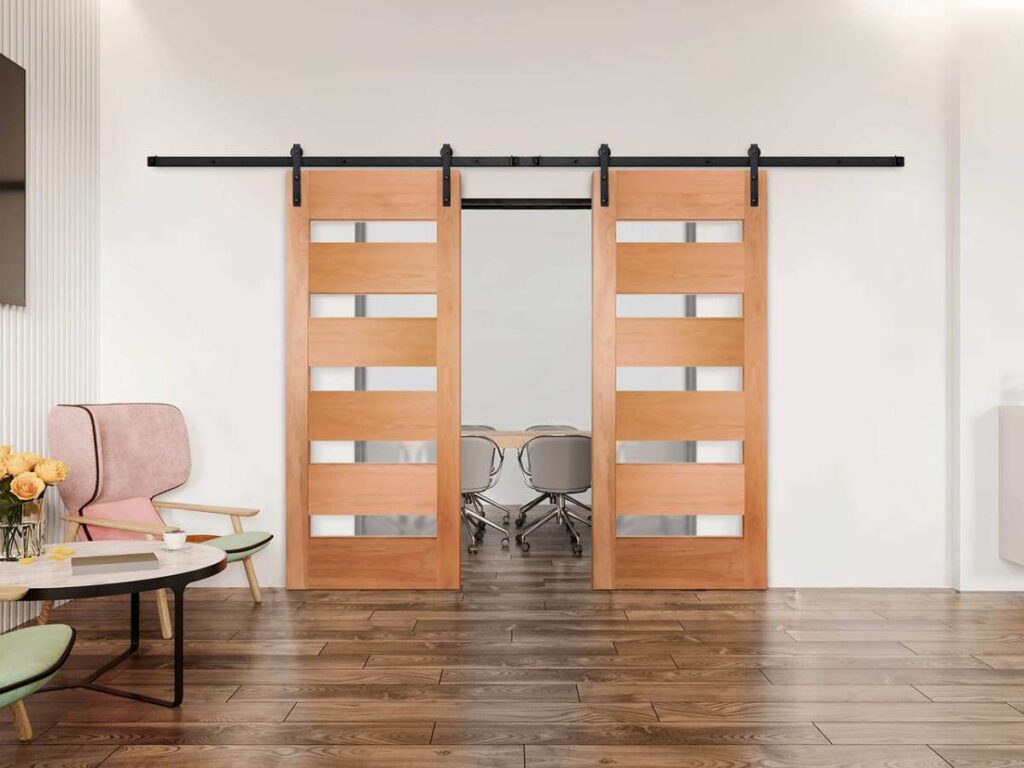
7. Durability & Maintenance
In long-term projects like hotels or villas, how well a door holds up, and how easy it is to maintain, can affect your bottom line. I’ve seen some teams overlook this, only to deal with wear-and-tear issues a year later. Here’s what you should know about how pocket and barn doors compare:
Durability
Pocket Door
- Track System Is Hidden: Since the track is built inside the wall, it’s protected from dust and damage. But if something fails inside, it’s harder to fix or replace.
- Door Panel Is Less Exposed: The panel slides in and out of the wall, which helps avoid surface damage. That said, thinner panels can still warp over time if the quality is low.
Barn Door
- Exposed Hardware Wears Faster: Because the track and rollers are exposed, they can collect dust or get bumped in high-traffic areas. But they’re also easier to check and clean regularly.
- More Contact With People and Objects: Barn doors are always out in the open, so they’re more likely to get scratched or hit. You’ll need a solid panel and quality finish to stand up to daily use.
Maintenance
Pocket Door
- Harder to Access Moving Parts: If the rollers or track break, you may need to open the wall. This kind of repair usually requires a contractor, which adds time and cost.
- Not Ideal for Heavy Use: I usually suggest avoiding pocket doors in areas with high foot traffic or frequent opening and closing. The sliding system inside the wall can wear down faster under constant use.
Barn Door
- Easier to Inspect and Repair: The hardware is visible, so you can spot wear early. Replacing rollers or tightening the rail is simple and doesn’t require special tools.
- Regular Cleaning Needed: Since the door and rail are exposed, they’ll collect dust and dirt. A quick wipe-down is usually enough, but it should be part of routine maintenance.
Final Thoughts
If easy repairs and quick access to parts are a priority, barn doors are easier to manage long term. Pocket doors offer a cleaner look, but their hidden parts can be harder and costlier to fix if something goes wrong.
Think about how often the door will be used and who will maintain it. That helps you pick the right option for your building or client.
8. Moisture & Climate Considerations
I’ve seen doors fail early just because no one thought about the humidity or local climate. This matters a lot in Southeast Asia and parts of Europe, where moisture levels can shift with the season. Let’s go over how both pocket and barn doors handle these conditions:
Moisture
Pocket Door
- Trapped Moisture in Wall Cavity: Pocket doors slide into a wall cavity, which can trap moisture if the space isn’t sealed well. In damp areas like bathrooms, this can lead to mold or swelling around the frame.
- Panel Can Warp Over Time: If the door material isn’t moisture-resistant, it may start to bend or stick. I’ve seen this happen often in coastal or high-humidity zones when the wrong material is used.
Barn Door
- Better Airflow Around the Door: Since barn doors are exposed on the outside, they get more air circulation. This lowers the risk of trapped moisture or mold buildup.
- Still Needs Proper Finishing: If the door is made from wood, it still needs a sealed surface. Unfinished panels can absorb moisture and change shape over time.
Climate Considerations
Pocket Door
- Expands and Contracts Inside Wall: In areas with big temperature swings, the wall cavity and door can both shift slightly. This may affect how smoothly the door slides over time.
- More Impact From Indoor Conditions: Since it’s hidden, the pocket door is more influenced by indoor temperature and ventilation. This can make it harder to manage in rooms without steady airflow.
Barn Door
- Performs Better in Mixed Conditions: Barn doors tend to hold up better across different temperature and humidity levels. Their exposed setup helps reduce swelling or sticking.
- Materials Matter More Than Setup: Even with better airflow, using stable materials like treated wood, aluminum, or composite panels is key. That’s what keeps the door working right in different climates.
Final Thoughts
If your project is in a humid or tropical area, barn doors usually have fewer issues with moisture and airflow. Pocket doors can still work, but they need more planning and the right materials to avoid long-term problems.
Think about where the door will go and what kind of air and moisture it’ll be exposed to. That will help you avoid extra repair or replacement costs down the line.
9. Cost Considerations
Cost is always part of the decision, especially when you’re handling multiple rooms or units. I’ve worked with project teams who underestimated door costs because they only looked at the sticker price, not the full setup. Let’s break down what you’re really paying for with pocket doors and barn doors:
Pocket Door
- Wall Work Adds to Labor: Installing a pocket door usually means cutting into or building a cavity in the wall. This adds labor time and often needs a skilled carpenter or builder.
- Track System Is Built-In: Since the track is hidden, it needs to be installed during framing or wall remodeling. This kind of system tends to be more expensive than surface-mounted tracks.
- Repair Costs Can Be Higher: If the sliding mechanism breaks, repairs can involve opening up the wall. I’ve seen teams deal with unexpected labor charges for small issues.
- Hardware and Materials Are Often Custom-Fit: Many pocket door kits are designed for specific wall depths or layouts. That means you might not be able to reuse hardware or swap in cheaper parts later.
Barn Door
- Simpler Installation Saves Time: Barn doors install on the surface, so there’s less labor involved. Most setups can be handled in a day without changing the wall.
- More Price Options for Hardware: You’ll find barn door tracks and handles in a wide price range. That gives you more flexibility to meet your budget, especially for multi-unit builds.
- Door Panel Can Be Standard or Custom: You can use a standard slab door or order a custom style. Both are available at many price points, depending on the look you’re going for.
- No Hidden Costs Later On: Since the parts are exposed, repairs and replacements are simpler and cheaper. It’s easier to control future maintenance costs.
- More Style Per Dollar: I’ve had clients choose barn doors just for the visual impact. You can get a strong design statement without spending much more than basic finishes.
Final Thoughts
Pocket doors often cost more upfront because of the wall work and hidden hardware. They work best if planned early in the build. Barn doors are more flexible with cost, faster to install, and easier to maintain.
If you’re managing a tight budget across many rooms, barn doors may give you more control. But if the layout calls for a cleaner look, the extra cost of a pocket door might be worth it.
10. How to Choose Between a Pocket Door and a Barn Door
At this point, you’ve seen how both doors stack up in different areas. But choosing the right one still depends on how you’ll use the space, your project goals, and the build itself. I’ve walked clients through this decision many times. Here’s how I suggest you think about it:
Look at Your Wall Conditions
The wall layout is one of the first things to check. If you can’t open the wall or don’t want to touch electrical or plumbing lines, a barn door is the simpler path. Pocket doors need an open cavity, and that’s not always possible in existing buildings.
Also, don’t forget to check how much clear wall space is next to your opening. Barn doors need room to slide. If there’s a window, light switch, or built-in fixture in the way, it may not work.
Consider the Use of the Room
Think about who will use the room and how often. For high-traffic areas like hotel corridors or shared family spaces, barn doors are easier to maintain and fix. They also work well in open layouts where full privacy isn’t needed.
On the other hand, if you’re working with smaller guest rooms, private baths, or offices where space is tight, a pocket door may be better. It disappears into the wall and gives you more room to move around. Function comes first here, form follows.
Think About Sound and Privacy Needs
Some projects need more privacy than others. If you’re planning rooms for guests, bathrooms, or quiet work areas, pocket doors provide better sealing. They’re not perfect, but they give more coverage than barn doors.
Barn doors have visible gaps and don’t block sound well. I wouldn’t recommend them for rooms where people need quiet or privacy. If you’re set on using them, it’s best to place them in lounges, entryways, or other shared areas where sound is less of an issue.
It all depends on the purpose of the space.
Factor in Budget and Labor
If you’re managing multiple units or properties, budget matters. Barn doors usually win in terms of speed and labor cost. You don’t have to open walls or deal with hidden framing, which saves time and money.
Pocket doors cost more to install and repair, but they offer a cleaner look. If the design calls for something seamless, they may be worth the extra cost. I’ve seen clients go both ways depending on what their space needs most.
Vallisco offers both door types with a range of options that match different project sizes and budgets. The right call often comes down to what’s most important, looks, function, or ease of build.
Conclusion
Remember the B&B that had to rebuild their walls? They now use pocket doors, and said they’d never skip that planning step again.
That’s why we built this guide. To give you clear answers on how pocket doors and barn doors compare. You’ve got what you need to make the right call for your project.
Before choosing, review the pros and cons. Match them to your layout, budget, and climate.
Still have questions? We’re ready to help.
Talk to Vallisco today, we’ll help you choose doors that work as hard as your build does.
Dive Deeper Into Our Resources
Looking for more product options? Take a look at our carefully chosen selections to find what suits your needs best:
Still haven’t found what you’re looking for? Don’t hesitate to contact us. We’re available around the clock to assist you.


